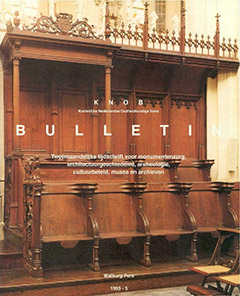Indexering ESCI / Scopus


Ester Vink: Bosch bouwhout onderweg. Een historisch onderzoek naar de herkomst van Bosch bouwhout in de vijftiende en zestiende eeuw. Victor M. Schmidt: Een verdwenen priestergestoelte uit de Sint-Janskathedraal te 's-Hertogenbosch. R.F. van Dijk en H J. van Nieuwenhoven: De klokken van Giessen-Oudekerk en Oosterwijk.
Around the mid-sixteenth century the organization of the timber trade seems to have developed to such an extent that it was mainly pretreated types of timber that could be offered to the buyers. These consisted of local timber as well as of timber that had been supplied from a longer distance. The timber supplied chiefly came from the German Mid-Rhine region and from the basin of the Maas and its tributaries in present-day South Belgium and Luxemburg.
The greater part of the local timber came from the ‘Meierij van 's-Hertogenbosch’ (bailiwick of 's-Hertogenbosch). The origin of...
In this article a piece of pre-Reformation furniture in the cathedral of 's-Hertogenbosch is discussed. The main source for the original furnishings of the choir and chancel is a series of drawings made by Pieter Jansz. Saenredam during the summer of 1632. One of them shows a wooden construction to the right of the main altar (Fig. 1).
Although a number of recent studies have discussed the original decoration of the choir (notes 1 and 2), this detail so far has eluded a satisfactory explanation. It is argued here that it represents now lost sedilia, i.e. a triple seat for the...
In 1542 the church of Giessen-Oudekerk acquired a new clock, which was probably melted down again by the Sea Beggars in 1572. In 1548 the church of Oosterwijk acquired a clock dating from 1502, which had presumably been taken from North France as war booty in 1537.


open access mogelijk gemaakt door Stichting OpenAccess
